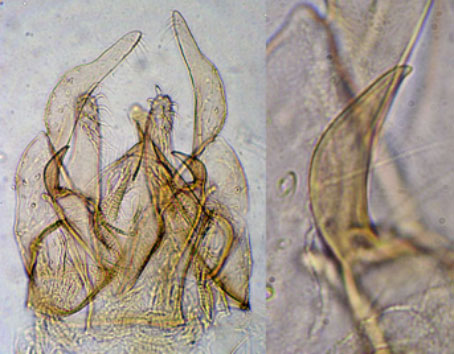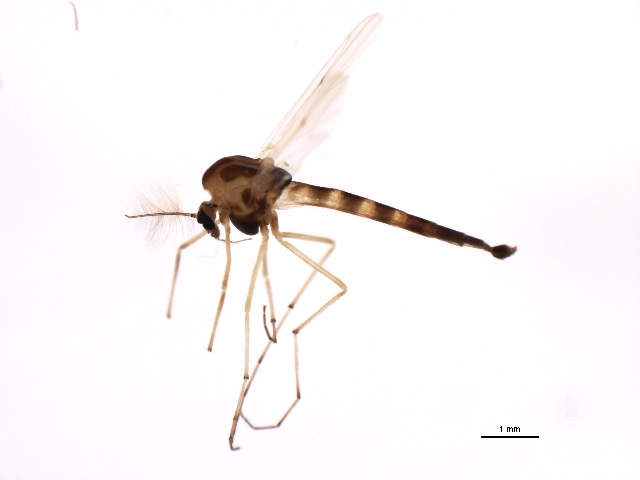Species 2b. C. 'proulxi' |
| | | | | | | | | | | |
| | | | | | | | | | | |
| | | | | | | | | | | |
| | | | | | | | | | | |

Male hypopygium (left) and Superior volsella (right) of a male from the same egg mass as the holotype
Some additional information can be provided from other males from the same egg mass, and from a male from a photograph in the BOLD database:
Coloration much as C. bifurcatus, but knees and anterior tarsi darkened.
Basal dark band at anterior of abdominal tergites, broader at mid-line and becoming more extensive until segs. VI-IX are almost completely dark.
Wing length 2.78-3.8 mm, width 0.68-0.9 mm, VR 0.98-1.03; 3-4 SCf on brachiolum, about 19-34 setae on squamal fringe.
Head: AR 3.14-3.5; cephalic tubercles 35-45 µm long and about 1.8-3.5 times longer than wide; seta not visible. Palp proportions (micron) 75 : 51 : 173 : 210 : abt 265. Clypeus about 0.5-0.7 of the width of the antennal pedicel, with 28-32 setae.
Thoracic setae: Acrostichal 10-16; dorsolateral 21-28 beginning at anterior end of lateral vittae; prealar 6-7; Supra-alar 1; Scutellar 11 in 2 approximate anterior rows, 14, mostly larger, in posterior row.Approximate leg proportions (micron):
BR 1.7-2.0
About 7-8 setae in a single patch on TIX. Superior volsella closest to E(g) of Strenzke (1959); IVo with simple setae, reaching to about the middle of the gonostylus which tapers noticably over posterior third.

C. bifurcatus male from Arizona
Female
Coloration essentially as in the male.
Wing length about 3.48-4.1 mm, width abt 1.02 mm; VR 1.08; abt 21 setae on squamal fringe; 3-4 SCf on brachiolum.
Antennal proportions (micron) 190 : 120 : 125 : 115 : 185; AR - 0.34; A5/A1 - 0.97. Cephalic tubules about 28-32 µm long and about 1.4-1.6 times longer than wide. Clypeus about twice the width of the antennal pedicel, about 39 clypelal setae.
Palpal proportions (micron) 65 : 50 : 190 : 230 : 310.
Thoracic setae: Acrostichal 17; Dorsocentral 35; Prealar 6; Supraalar 1: Scutellar 15 scattered anteriorly, 14 in posterior row.
Approximate leg proportions (micron):
BR about 1.82
Pupa, Fourth instar larva and Cytology - Go to C. 'proulxi' immatures.
Found: British Columbia – North Pender Island, Gulf Islands N.P. (48.781°N, 123.301°W)(BOLD); Kelowna C.S., Kelowna
(49.863°N, 119.454°W)(BOLD).
New Brunswick – Kouchebouguac National Park (46.50°N, 65.33°W).
Ontario – abt 5 km NE Bobcayeon, Kawartha (44.57°N, 78.5°W) (BOLD); Brockville (44.589°N, 75.689°W)(BOLD); A.B.Lucas SS
(43.033°N, 81.248°W) London (BOLD); 4 ml e. Sudbury (46.52°N, 80.90°W); Sudbury area (Proulx et al.);
McFarlane L. (46.42°N, 80.95°W), and Tilton L. (46.35°N, 81.07°W), Peterborough (44.271°N, 78.394°W)(BOLD).
Prince Edward Island – Bubbling Springs Trail PEI Nat. Pk. (46.411°N, 63.093°W)(BOLD).
Quebec – L. St. Joseph (46.88°N, 71.63°W); L.Kinojévis (48.13°N, 78.90°W) (Proulx et al.).
Saskatchewan – Grasslands Nat. Pk. (49.001°N, 106.557°W); Prince Albert Nat. Pk., (53.85°N, 106.078°W)(both BOLD).
Arizona – at 2033 m Kaibab National Forest (35.939°N, 112.121°W)(BOLD).
Oregon – Rolling Riffle Creek, e. Dexter, Lane Co. (43.90°N, 122.8°W).
Tennessee – 10-Mile Creek, nr. Knoxville, Knox Co. (35.90°N, 84.07°W).
Wisconsin – Arboretum (43.03°N, 89.42°W) and University Houses (43.07°N, 89.42°W), Madison, Dane Co.
Molecular sequences:
MtCOI: This species can be separated from the closely related C. bifircatus at the molecular level on the basis of consistent differences at 10 base pairs:
| | | | | | | | | | |
| | | | | | | | | | |
| | | | | | | | | | |
| | | | | | | | | | |
| | | | | | | | | | |
Pools and creeks.
Modified: 7 June 2021
Access: Unrestricted
Copyright © 2000-2021, Jon Martin.